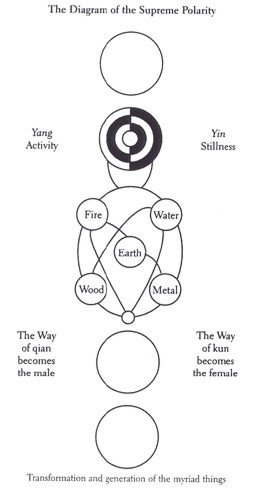Joseph A. Adler
“Diagram of the Supreme Polarity” (Taiji tu)
“Explanation of the Diagram of the Supreme Polarity” (Taijitu shuo)
- Non-polar (wuji) and yet Supreme Polarity (taiji)! The Supreme Polarity in activity generates yang; yet at the limit of activity it is still. In stillness it generates yin; yet at the limit of stillness it is also active. Activity and stillness alternate; each is the basis of the other. In distinguishing yin and yang, the Two Modes are thereby established.
- The alternation and combination of yang and yin generate water, fire, wood, metal, and earth. With these five [phases of] qi harmoniously arranged, the Four Seasons proceed through them. The Five Phases are simply yin and yang; yin and yang are simply the Supreme Polarity; the Supreme Polarity is fundamentally Non-polar. [Yet] in the generation of the Five Phases, each one has its nature.
- The reality of the Non-polar and the essence of the Two [Modes] and Five [Phases] mysteriously combine and coalesce. “The Way of Qian becomes the male; the Way of Kun becomes the female;” the two qi stimulate each other, transforming and generating the myriad things. The myriad things generate and regenerate, alternating and transforming without end.
- Only humans receive the finest and most spiritually efficacious [qi]. Once formed, they are born; when spirit (shen) is manifested, they have intelligence; when their five-fold natures are stimulated into activity, good and evil are distinguished and the myriad affairs ensue.
- The Sage settles these [affairs] with centrality, correctness, humaneness and rightness (the Way of the Sage is simply humaneness, rightness, centrality and correctness) and emphasizes stillness. (Without desire, [he is] therefore still.) In so doing he establishes the ultimate of humanity. Thus the Sage’s “virtue equals that of Heaven and Earth; his clarity equals that of the sun and moon; his timeliness equals that of the four seasons; his good fortune and bad fortune equal those of ghosts and spirits.” The superior person cultivates these and has good fortune. The inferior person rejects these and has bad fortune.
- Therefore [the Classic of Change says], “Establishing the Way of Heaven, [the Sages] speak of yin and yang; establishing the Way of Earth they speak of yielding and firm [hexagram lines]; establishing the Way of Humanity they speak of humaneness and rightness.” It also says, “[The Sage] investigates beginnings and follows them to their ends; therefore he understands death and birth.” Great indeed is [the Classic of] Change! Herein lies its perfection.
Luc Paquin

Leave a Reply